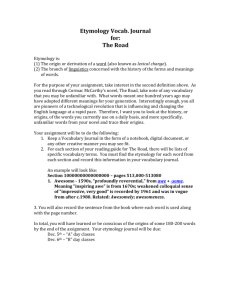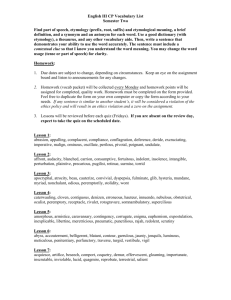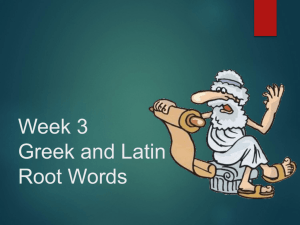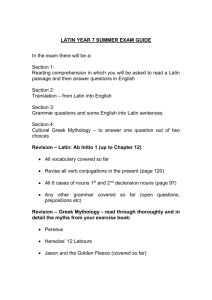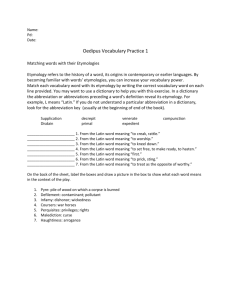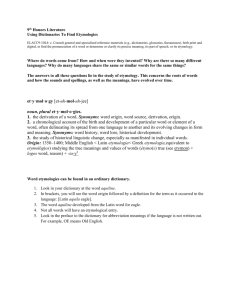Latin Via Ovid
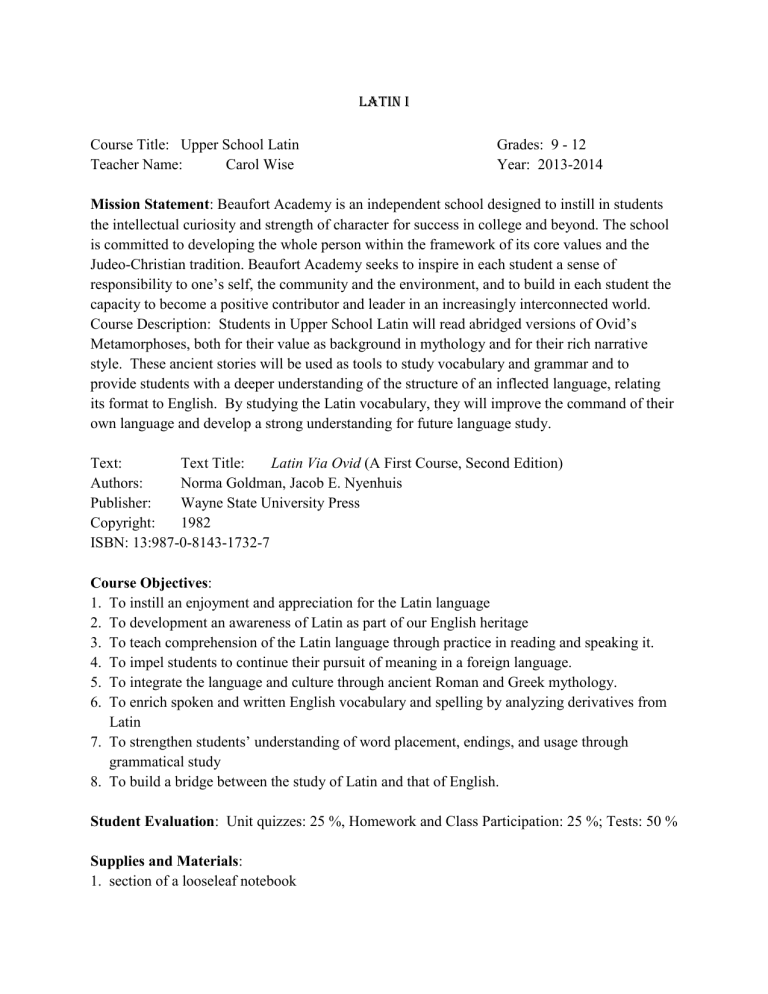
Latin I
Course Title: Upper School Latin
Teacher Name: Carol Wise
Grades: 9 - 12
Year: 2013-2014
Mission Statement : Beaufort Academy is an independent school designed to instill in students the intellectual curiosity and strength of character for success in college and beyond. The school is committed to developing the whole person within the framework of its core values and the
Judeo-Christian tradition. Beaufort Academy seeks to inspire in each student a sense of responsibility to one’s self, the community and the environment, and to build in each student the capacity to become a positive contributor and leader in an increasingly interconnected world.
Course Description: Students in Upper School Latin will read abridged versions of Ovid’s
Metamorphoses, both for their value as background in mythology and for their rich narrative style. These ancient stories will be used as tools to study vocabulary and grammar and to provide students with a deeper understanding of the structure of an inflected language, relating its format to English. By studying the Latin vocabulary, they will improve the command of their own language and develop a strong understanding for future language study.
Text: Text Title: Latin Via Ovid (A First Course, Second Edition)
Authors: Norma Goldman, Jacob E. Nyenhuis
Publisher: Wayne State University Press
Copyright: 1982
ISBN: 13:987-0-8143-1732-7
Course Objectives :
1. To instill an enjoyment and appreciation for the Latin language
2. To development an awareness of Latin as part of our English heritage
3. To teach comprehension of the Latin language through practice in reading and speaking it.
4. To impel students to continue their pursuit of meaning in a foreign language.
5. To integrate the language and culture through ancient Roman and Greek mythology.
6. To enrich spoken and written English vocabulary and spelling by analyzing derivatives from
Latin
7. To strengthen students’ understanding of word placement, endings, and usage through
grammatical study
8. To build a bridge between the study of Latin and that of English.
Student Evaluation : Unit quizzes: 25 %, Homework and Class Participation: 25 %; Tests: 50 %
Supplies and Materials :
1. section of a looseleaf notebook
2. lined paper
3. 8 packages of 3x5 index cards (for flashcards)
General Expectations :
1.
Students will be prepared to learn at the beginning of class with the proper supplies and
mindset for erudition.
2. Students will maintain proper class decorum and respect the individuality of classmates.
3. Students will memorize all assigned vocabulary words and grammatical concepts and be
able to apply them to class Latin translations.
4. Students will recognize English derivatives from Latin and be able to apply them to their
writing and speaking of English.
5. Students will explore the Roman and Greek culture and recognize their influence on
today’s world.
6. Students will complete all homework assignments and be responsible for bringing them
to class in their Latin notebook.
7. Students will use electronical devices only when directed to do so. Otherwise,
electronics will be kept in class caddy.
8. All BA Blue Book Rules will be enforced. Students should pay particular attention to
attendance requirements: (1) Any absence in excess of five class periods in one trimester will
result in a 3% lowering of the final trimester grade. Four tardies in a class count as one
absence and fall within this policy. (2) All students are required to be in their first period
classroom at 8:00AM each day of school. Students arriving any time after 8:00AM are
considered tardy. Students will be allowed two unexcused tardy days per trimester. On the
third tardy, the school will send an electronic warning to the parents to inform them a work
detail or a detention will be assigned on the fourth tardy of the trimester. (3) Students who
arrive at school after 8:30AM on the day of an athletic contest or performing arts presentation
will not be allowed to participate in that contest or presentation. Exceptions may be granted
by the administration for legitimate reasons and such exceptions must be pre-approved.
Academic Expectations
1.
Students will prepare flashcards for assigned vocabulary words and memorize
pronunciation and meaning of words as soon as they are introduced.
2. Students will apply vocabulary words and their inflections to new translations and
practice translations until proficiency is reached.
3. Students will be able to recognize the cases, declensions, and conjugations of Latin words
in assigned translations.
4. Students will be able to decipher the meaning of English words through their Latin etymology.
Course Overview
LATIN VIA OVID features abridged versions of Ovid’s
Metamorhoses for its assigned readings, which provide a background in mythology and a rich narrative style designed to motivate the reader. The chapters are divided into sections of vocabulary, translation, grammar, and etymology. The grammar concepts are the foundation of the language instruction and should enrich the student’s understanding of the Latin language, as well as that of English. The translations are designed to showcase the new concepts as they are introduced. Each lesson contains a brief dialogue of a few words of basic communication, not intended to teach the student to speak the language but rather to appreciate the beauty of its sound. The etymology sections are intended to enrich the student’s English vocabulary and word-building awareness.
Each section works both with the principles of word development in English by means of roots, prefixes, and suffixes, and also with specific words from the lesson. Etymology is expanded to add a note on Roman education, names, food, clothing, and housing.
As an independent course, much of the work’s completion will rest with the student’s ability to follow the timeline set by the instructor. The instructor will meet with the student every
Monday during his/her activity period (at the end of the day) and daily at the beginning of his/her mid-morning “break” to check assignments and to introduce new concepts and hone assigned translations. Grading will be divided into the categories of homework, quizzes, and tests. The student will need to maintain a Latin notebook, which will contain his/her translations, graded tests, and any handouts distributed by the instructor. Tests will be given for each unit, and a portfolio will be submitted as an exam grade.
I.
Latin Via Ovid
Unit One
A.
CARTA GEOGRAPHIC
1.
Grammar a.
Nominative, Accusative, Ablative Cases b.
Questions and Answers c.
Singular and Plural
2.
Etymology: Geographical Etymology
B.
EUROPA ET TAURUS
1.
Grammar a.
Genitive and Accusative Cases b.
Present Tense c.
Person and Number
2.
Etymology: Roots and Prefixes
C.
MINERVA ET ARACHNE ( Pars Prima )
1.
Grammar
a.
Parts of Speech b.
Inflection c.
Number d.
Gender e.
Case f.
Commands
2.
Etymology: Latin As a Basis for the Romance Languages
D.
MINERVA ET ARACHNE (Pars Secunda )
1.
Grammar a.
Infinitive b.
Stem c.
First and Second Conjugation d.
Linking verb Sum e.
Dative Case f.
Imperative g.
Vocative h.
Principal Parts
2.
Etymology: Suffix Changes
E.
MINERVA ET ARACHNE ( Pars Tertia )
1.
Grammar a.
Imperfect Tense b.
Dative Case Usage c.
Imperative Mood d.
Vocative Case e.
Imperfect of sum
2.
Etymology: suffix changes
II.
Unit II
A.
LATONA ET NIOBE ( Pars Prima )
1.
Grammar a.
Second Declension b.
Masculine and Neuter c.
Agreement of Nouns and Adjectives d.
Cardinal Numbers e.
Roman Numerals
2.
Etymology: via ; suffix – ion; -tia > - ce
B.
LATRONA ET NIOBE ( Pars Secunda )
1.
Grammar a.
First and Second Declension Adjectives b.
Ablative of Means c.
Vocative in –e
d.
Number Practice
2.
Etymology: Numbers and Roman Numerals
C.
PAN ET SYRINGA
1.
Grammar a.
Future Tense b.
Nouns in –er and –ir in Second Declension c.
Future of sum
2.
Etymology: colo , osus , Latin to English Words Intact
D.
CALLISTO ( Pars Prima )
1.
Grammar a.
Perfect Tense b.
Dative with Certain Adjectives c.
Conditons ( Si Clauses) d.
suus and eius
2.
Etymology: The Zodiac
E.
CALLISTO ( Pars Secunda )
1.
Grammar a.
Perfect Tense Forms b.
Perfect form of sum c.
absum, adsum d.
Principal Parts of Verbs
2.
Etymology: Persona , Identical Cognates
III.
Unit Three
A.
PHILEMON ET BAUCIS ( Pars Prima )
1.
Grammar a.
Third Declension b.
I-Stems c.
Duo, Duae, Duo d.
Mille, Milia e.
Partitive Genitive
2.
Etymology: Domus, Rex
B.
PHILEMON ET BAUCIS ( Pars Secunda )
1.
Grammar a.
Neuter Third Declension b.
Video + Infinitive c.
Substantives d.
Principal Parts
2.
Etymology: Who Invented the Motor Car?
C.
ECHO ET NARCISSUS
1.
Grammar
a.
Superlatives b.
Ablative Usage c.
Quem d.
Future Perfect
2.
Etymology: Assimilation, pos - and pot - words.
D.
PHOEBUS ET DAPHNE
1.
Grammar a.
Third Conjugation b.
Third – io c.
Personal Pronouns d.
Parts of the Body
2.
Etymology: Aqua, Dico, Facio
IV.
Unit Four
A.
PYRAMUS ET THISBE ( Pars Prima )
1.
Grammar a.
Fourth Conjugation b.
Future Tense c.
Synopsis of Verbs d.
Reflexive Pronouns
2.
Etymology: arium, -orum
B.
PYRAMUS ET THISBE ( Pars Secunda )
1.
Grammar a.
Demonstratives Hc and Ille b.
Imperative Mood
2.
Etymology: Space Age Vocabulary
C.
ATALANTA ET HIPPOMENES ( Pars Prima )
1.
Grammar a.
Passive Vocie b.
Ablative of Agent c.
Relative Pronoun d.
Passive Infinitive
2.
Etymology: Dexter, Sinister, Augur
D.
ATALANTA ET HIPPOMENES ( Pars Secunda )
1.
Grammar a.
Perfect Passive Participle b.
Quis c.
Quid d.
Eo
e.
Passive of video
2.
Etymology: -or , Romance Language Cognates
V.
Unit Five
A.
MIDAS ET VIS AUREA
1.
Grammar a.
Ablative Absolute b.
Principal Parts of Verbs c.
Fifth Declension d.
Third Declension Adjectives
2.
Etymology: -tas, -tudo, -io, -idus
B.
MIDAS ET PAN
1.
Grammar a.
Perfect Passive b.
Idem, Eadem, Idem c.
Deponent Verbs d.
Onomatopoeia e.
Declension of se
2.
Etymology: Piscis in Mari
C.
ORPHEUS ET EURYDICE
1.
Grammar a.
Conjugation of fero b.
Third Declension Adjectives c.
Participles
2.
Etymology: Latin in Musical Terms
D.
MORS ORPHEI
1.
Grammar a.
Future Active Participle b.
Active Periphrastic c.
Comparison of Adjectives, Adverbs d.
Infinitives e.
Compounds of eo
2.
Etymology: Musical Terms
INTERIM READING: DAEDALUS ET ICARUS (177)
VI.
Unit Six
A.
IASON ET ARGONAUTAE
1.
Grammar a.
Indirect Statement b.
Nego
c.
Quidam, Quaedam, Quiddam d.
Irregular Adjectives
2.
Etymology: Geographical Terms
B.
AMOR IASONIS
1.
Grammar a.
Subjunctive: Active and Passive b.
Subjunctive of Sum and Possum c.
Subjunctive Usage
2.
Etymology: Islands, Rivers, Seas Cities
C.
LABORES IASONIS
1.
Grammar a.
Subjunctive: Imperfect Active and Passive b.
Subjunctive Usage: Purpose and Result Clauses c.
Subjunctive use of sum
2.
Etymology: Legal Latin
D.
FACTA MAGICA MEDEAE
1.
Grammar a.
Perfect Subjunctive b.
Pluperfect Subjunctive Conditions c.
Dative Usage
2.
Etymology: Medical Latin
INTERIM READING ii: PHAETHON (203)
VII.
Unit Seven
A.
THESEUS TROEZENE
1.
Grammar a.
Synopsis of Subjunctive b.
Indirect Question c.
Sequence of Tenses d.
Utor with Ablative e.
Location Case
2.
Etymology: Church Latin
B.
THESEUS ATHENIS
1.
Grammar
1.
Cum, Preposition and Conjunctive
2.
Cum Clauses
3.
Comparison of Adjectives
4.
Superlative
2.
Etymology: Biological, Botanical, and Zoological Latin
C.
THESEUS CRETAE
1.
Grammar a.
Relative Clauses with Indicative and Subjunctive b.
Impersonal Verbs c.
Gerund With Genitive
2.
Etymology: Psychological Latin
D.
THESEUS REX
1.
Grammar a.
Noun Clause of Desire b.
Subjunctive by Attraction c.
Subjunctive After Verbs of Fearing f.
Accusative of Extent of Time
2.
Etymology: Days of the Week d.
Inverted Cum Clause e.
Accusatie of Place to Which
INTERIM READING iii: FACTA MALA MEDEAE (251)
VIII.
Unit Eight
A.
BELLUM TROIANUM: SACRIFICIUM IPHIGENIAE
1.
Grammar a.
Conditions b.
Reading Poetry
2.
Etymology: Months of the Year
B.
BELLUM TROIANUM: MORS CYGNI
1.
Grammar a.
Deponent and Semi-Deponent Verbs b.
Indirect Questions c.
Genitive Case d.
Future Imperative e.
Double Dative
2.
Etymology and Roman Life: Education and Terms
C.
BELLUM TROIANUM: AIAX ET ULIXES
1.
Grammar a.
Accusative Uses b.
Pronouns of Latin c.
Irregular Verb Fio d.
Questions: Nonne and Num
2.
Etymology and Roman Life: Names and Families
D.
BELLUM TROIANUM: TROIA CAPTA
1.
Grammar a.
Review of Participles b.
Passive Periphrastic with the Gerundive c.
Review of Numbers d.
Review of Ablative Usage
2.
Etymology and Roman Life: Tombstone Latin
INTERIM READING; PLUTO ET PROSERPINA (267)
IX.
Unit Nine
A.
THE ODYSSEY
1.
Grammar Review
2.
Etymology and Roman Life: Foods
B.
AENEAS
1.
Grammar a.
Supine to Express Purpose b.
Other Means of Expressing Purpose
2.
Etymology and Roman Life: Clothing
C.
ACHAEMENIDES
1.
Grammar a.
Ablative of Comparison b.
Verbs of Remembering and Forgetting (Genitive) c.
Aids in Translation
2.
Etymology and Roman Life: An Insula is Not a Domus
D.
CIRCE
1.
Grammar a.
Gerund and Gerundive b.
Review of the Passive Periphrastic
2.
Etymology: Latin in Mathematics and Geometry
INTERIM READING iv: CEYX ET ALCYONE (395)
X.
Unit X
A.
SIBYLLA CUMAEA
1.
Grammar a.
Review of the Vocative b.
Review of the Passive Forms
2.
Etymology: Latin Abbreviations in English
B.
AENEAS IN ITALIA
1.
Grammar - The Many Uses of the Dative Case
2.
Etymology: Latin Words, Mottos, Phrases in English
